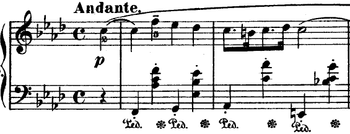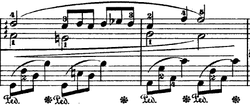
Nocturnes Op. 55 (Chopin)
Encyclopedia

Frédéric Chopin
Frédéric François Chopin was a Polish composer and virtuoso pianist. He is considered one of the great masters of Romantic music and has been called "the poet of the piano"....
consisted of two nocturne
Nocturne
A nocturne is usually a musical composition that is inspired by, or evocative of, the night...
s, his fifteenth and sixteenth, dedicated to his pupil Jane Stirling
Jane Stirling
Jane Stirling was a Scottish amateur pianist who is best known as a student and later friend of Frédéric Chopin; two of his nocturnes are dedicated to her. She took him on a tour of England and Scotland in 1848, and took charge of the disposal of his effects and manuscripts after his death in 1849...
. The pair were composed between 1842 and 1844, and published in August 1844.

Nocturne in F minor, Op. 55, No. 1
Composed in 1842-1844, Chopin's Op. 55, No. 1 has an average duration of about 5 minutes. The piece has been played by many famous pianists.
Structure
The piece is in F minor and is also in ternary form (ABA)Ternary form
Ternary form, sometimes called song form, is a three-part musical form, usually schematicized as A-B-A. The first and third parts are musically identical, or very nearly so, while the second part in some way provides a contrast with them...
. Its main theme has a slow 4/4 with a heavy, steady crotchet beat.
The piece starts with the main theme which repeats once with only minor variations. The right hand plays a slow melody and the left hand accompanies with a bass note and then a chord, in crotchets. The second section is then played with, again, the right-hand playing the melody and the left-hand accompanying with bass notes and a chord. Although there are occasional changes to this pattern, for example the left-hand plays a sustained minim with a crotchet chord above. The main theme then comes back in with some variations to the first two times it was played: a triplet phrase is added to the 3rd bar of the section. The second section is again repeated with no variations, followed immediately by the first section again with the triplet sequence.
A tempo change to più mosso speeds up the piece. It starts off with some fast, triplet quavers and then three loud (forte
Forte
Forte/Forté may refer to:*Forte, but often ;. A person's strong point e.g. Preparing gourmet cuisine is his forte. The term is derived from the French fort meaning strength, which does not include an acute accent. The latter pronunciation is likely due to a confusion as a false cognate with the...
) chords. This then repeats three further times until a completely new section comes in with a melody in the right hand and triplet broken chords in the left (see score on right). A descending scale and some large chords completes this section and leads it onto the first theme again.
There is then a large variation on the first theme where the main tune is played with other notes in between. There is then a large section of arpeggios and finishing off on 6 final chords. Modulating to the major (F major) for an interrupted final cadence.
There are two short chorales. The first, at bars 71-72 marks the transition from B section back to A, while the second, at 98-101, concludes the piece, in F major.
The piece was described by Frederick Niecks
Frederick Niecks
Frederick Niecks was a German musical scholar and author, who was resident in Scotland for the bulk of his life. He is best remembered now for his biographies of Frédéric Chopin and Robert Schumann.-Biography:...
(Chopin's biographer) as: "we will note only the flebile (feeble) dolcezza of the first and the last section, and the inferiority of the more impassioned middle section". Allmusic is more flattering: The melody has a "bittersweet tang", the B section "dramatic and anxious" culminating in an "exciting stretto", the whole "an effective entry-level piece for those players and listeners seeking a clear glimpse of the composer's basic style."
Nocturne in E-flat major, Op. 55, No. 2
The second nocturne, in E major, features a 12/8 time signature, triplet quavers in the bass, and a lento sostenuto tempo marking. Of this one, Niecks wrote:Allmusic is more positive:
Popular Culture
- It is featured in the 1997 action thriller The PeacemakerThe Peacemaker (1997 film)The Peacemaker is a 1997 American action/thriller film starring George Clooney and Nicole Kidman and directed by Mimi Leder. It is also notable as being the first film released by DreamWorks...
(starring George ClooneyGeorge ClooneyGeorge Timothy Clooney is an American actor, film director, producer, and screenwriter. For his work as an actor, he has received two Golden Globe Awards and an Academy Award...
and Nicole KidmanNicole KidmanNicole Mary Kidman, AC is an American-born Australian actress, singer, film producer, spokesmodel, and humanitarian. After starring in a number of small Australian films and TV shows, Kidman's breakthrough was in the 1989 thriller Dead Calm...
), where the main terrorist character (Marcel IureşMarcel IuresMarcel Iureş is a Romanian stage and screen actor.Iureş was born 2 August 1951 in Băileşti, Romania and is one of Romania's most acclaimed stage and film actors. Iureş entered the Institutul de Arta Teatrala si Cinematografica in Bucharest in 1974 and graduated in 1978...
as Dusan Gavrich), being a music teacher, explains a young girl how to properly 'feel' and interpret the nuances in the music and then he plays it for her on the piano. The piece starts out as a solo piano performance and then mushrooms into an incredibly beautiful full-blown orchestral arrangement.
External links
- Sheet music on IMSLP
Analyses
- David Heyer pp51-71 "An Analysis of the Chorales in Three Chopin Nocturnes: Op. 32, No.2; Op. 55, No.1; and the Nocturne in C# Minor (without opus number)". Masters thesis, University of Oregon, 2008-03.

